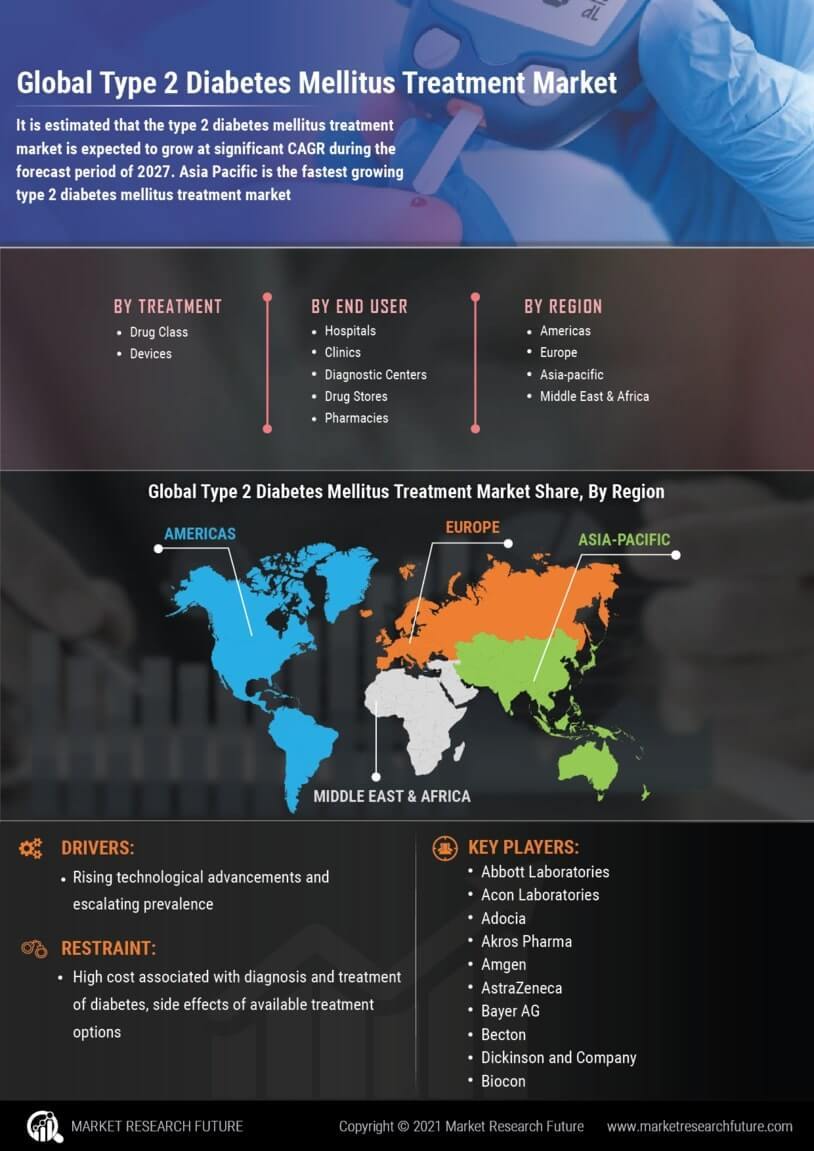Type 2 Diabetes Mellitus Treatment Market Scenario:
The Type 2 Diabetes Mellitus Treatment Market is expected to reach USD 39,673 Million by 2030 at 9.2% CAGR during the forecast period 2022-2030. Type 2 diabetes mellitus is a metabolic disorder which results from an excess of caloric intake over energy expenditure. The condition is characterized by progressive insulin secretory defect, which increases the body’s demand for insulin in order to retain glucose homeostasis. Hyperglycemia is a major symptom of type 2 diabetes mellitus. According to the National Diabetes Statistics Report suggested by CDC, it is found that 9.4% of the U.S. population, i.e. 30.3 million people had diabetes in 2015.
It is noted that rising technological advancements and escalating prevalence are the key factors driving the type 2 diabetes mellitus treatment market. With the rising awareness about the condition, market players are coming up with novel drugs and devices owing to technological advancements. For instance, in December 2017, Novo Nordisk received FDA approval for Ozempic (semaglutide). The drug was specially designed for the treatment of type 2 diabetes mellitus. In the same year, Merck has also received FDA approval for Steglatro (ertugliflozin).
Various other factors such as growing awareness, huge research funding in diabetes diagnosis and treatment, unmet medical needs, increasing global prevalence of obesity, improving regulatory framework, increasing government assistance, and increasing adoption rate, are continuously contributing to the growth of the global type 2 diabetes mellitus treatment market.
Despite these drivers, there are some issues associated with type 2 diabetes mellitus treatment market. The high cost associated with diagnosis and treatment of diabetes, side effects of available treatment options, and poor healthcare system in low and middle-income countries may hamper the growth of the market to an extent.
A chronic condition that affects the body's blood sugar level is type 2 diabetes (T2D). The cardiovascular system, blood vessels, kidneys, eyes, and nerves suffer negative effects from hyperglycemia or elevated blood sugar levels. The market for diabetes treatments has been paved for expansion by the rising prevalence of the disease and advancements in novel diabetes therapies, which have considerably improved the market's design and functioning. A metabolic disease called type 2 diabetes mellitus is brought on by a calorie surplus compared to energy expenditure. The increasing insulin secretory failure that characterizes the syndrome raises the body's need for insulin to maintain glucose homeostasis. One of the main signs of type 2 diabetes mellitus is hyperglycemia. The diabetes therapy market has been growing steadily due to several factors.
First, the market has been driven by an increase in healthcare spending. Additionally, the market for diabetic treatments is impacted by the growing elderly population. The need for diabetic therapies has been fueled by growing awareness of diabetes and its effects. Early diagnosis, improved management techniques, and a rise in demand for efficient treatment alternatives have all been made possible by education campaigns and efforts launched by medical organizations, governments, and advocacy for patients' organizations. Governments worldwide are implementing plans to fight diabetes and its associated issues. Campaigns to raise awareness, early screening applications, reimbursement rules, and financial incentives to create and adopt novel therapies are just a few of these activities. The increase in the prevalence of type 2 diabetes (T2D) disease worldwide is the main reason driving the growth of the T2D market globally.
The market for products, drugs, equipment, and treatments used for managing and treating diabetes is a worldwide diabetes treatment market. Due to the body's inability to efficiently generate or use the hormone insulin, which controls blood glucose levels, diabetes is a persistent medical illness marked by excessive blood sugar levels. However, the market expansion is constrained by patients' lack of knowledge about the accessible nature of such treatments. On the other hand, unmet medical demands in developing nations are anticipated to offer profitable market expansion potential.
The US Food and Drug Administration has authorized Bexagliflozin (Brenzavvy, TheracosBio) to receive treatment for adult patients with type 2 diabetes. For people with type 2 diabetes, but not those with type 1 diabetes, the once-daily 20-mg oral sodium-glucose cotransporter 2 (SGLT2) inhibitor is suggested as an addition to diet and exercise to enhance glycemic control. Adults having a glomerular filtration rate that has been estimated can utilize it. Bexagliflozin, either as a monotherapy or as an addition to metformin and other glucose-lowering medications and combinations, significantly decreased A1c and fasting blood glucose at twenty-four weeks in the phase 3 studies. Additionally, it led to moderate drops in systolic blood pressure and body weight.
Segmentation
The global type 2 diabetes mellitus treatment market is segmented on the basis of treatment and end user.
On the basis of the treatment, the market is classified as a drug class and devices. The drug class is further segmented into insulin, sensitizers, SGLT-2 inhibitors, alpha-glucosidase inhibitors, secretagogues, peptide analogs, others. The sub-segment of sensitizers includes thiazolidinediones and biguanides. The sub-segment of secretagogues includes sulfonylureas and non-sulfonylureas. The devices market is further segmented into blood glucose monitoring devices and insulin delivery devices. The sub-segment of blood glucose monitoring devices includes testing strips, lancets, continuous glucose monitors, self-monitoring blood glucose meters, and others. The sub-segment of insulin delivery devices includes insulin pens, insulin pumps, insulin syringes, and insulin jet injectors.
On the basis of the end user, the market is segmented into hospitals, clinics, diagnostic centers, drug stores, pharmacies, and others.
News
The treatment of type 2 diabetes in children 10 years of age and older has been approved by the US Food and Drug Administration for both empagliflozin (Jardiance, Boehringer Ingelheim) or empagliflozin coupled with metformin (Synjardy, BI). After metformin, which seems less successful for youngsters than adults, its approval offers an additional oral treatment choice for kids and teens with type 2 diabetes. For children with type 2 diabetes, injectable glucagon-like peptide-1 (GLP-1) agonists are also available. These include once-weekly extended-release exenatide (Bydureon/Bydureon BCise) and daily liraglutide (Victoza).
Regional Analysis
The Americas dominate the type 2 diabetes mellitus treatment market owing to the presence of patient population, a well-developed technology, high healthcare expenditure, and the presence of the leading players. Due to the rising prevalence of diabetes, various companies, and government associations are actively participating in improving diabetes care. For instance, The Merck Foundation has provided funding of around USD 10,000,000 for the projects designed to improve diabetes care in the United States.
Europe holds the second position in the type 2 diabetes mellitus treatment market. It is expected that the government support towards research & development expenditure and amendments in reimbursement policies in the healthcare is likely to drive the European market. As per the German maternity guidelines, every pregnant woman can undergo glucose challenge test for the early diagnosis of Gestational diabetes mellitus, and the charges for the test are completely covered by women’s health insurance.
Asia Pacific is the fastest growing type 2 diabetes mellitus treatment market owing to a huge patient pool, increasing demand, and development in healthcare technology.
The Middle East & Africa holds the lowest share of the global market due to low development, lack of technical knowledge, and poor medical facilities.
Key Players
Some of key the players in the global type 2 diabetes mellitus treatment market are Abbott Laboratories, Acon Laboratories, Inc., Adocia, Akros Pharma, Amgen, AstraZeneca, Bayer AG, Becton, Dickinson and Company, Biocon, Boehringer Ingelheim, Daiichi Sankyo, Eli Lilly, Merck, Novartis & Co., Novo Nordisk, Peptron, Pfizer, Roche Diagnostics Ltd., Sanofi, Sunpharma, Takeda Pharmaceuticals, and others.
Intended Audience
- Pharmaceutical Companies
- Medical Device Companies
- Research and Development (R&D) Companies
- Diagnostic Laboratories
- Government Research Institute
- Academic Institutes and Universities
|
Report Attribute/Metric
|
Details
|
|
Market Size
|
USD 39,673 Million
|
|
CAGR
|
9.2%
|
|
Base Year
|
2021
|
|
Forecast Period
|
2022-2030
|
|
Historical Data
|
2020
|
|
Forecast Units
|
Value (USD Million)
|
|
Report Coverage
|
Revenue Forecast, Competitive Landscape, Growth Factors, and Trends
|
|
Segments Covered
|
Treatment, Devices and End User
|
|
Geographies Covered
|
North America, Europe, Asia-Pacific, and Rest of the World (RoW)
|
|
Key Vendors
|
Abbott Laboratories, Acon Laboratories, Inc., Adocia, Akros Pharma, Amgen, AstraZeneca, Bayer AG, Becton, Dickinson and Company, Biocon, Boehringer Ingelheim, Daiichi Sankyo, Eli Lilly, Merck, Novartis & Co., Novo Nordisk, Peptron, Pfizer, Roche Diagnostics Ltd., Sanofi, Sunpharma, Takeda Pharmaceuticals
|
|
Key Market Opportunities
|
Growing awareness and huge research funding in diabetes diagnosis and treatment
|
|
Key Market Drivers
|
Rising technological advancements and escalating prevalence
|
Type 2 Diabetes Mellitus Treatment Market Highlights:



























